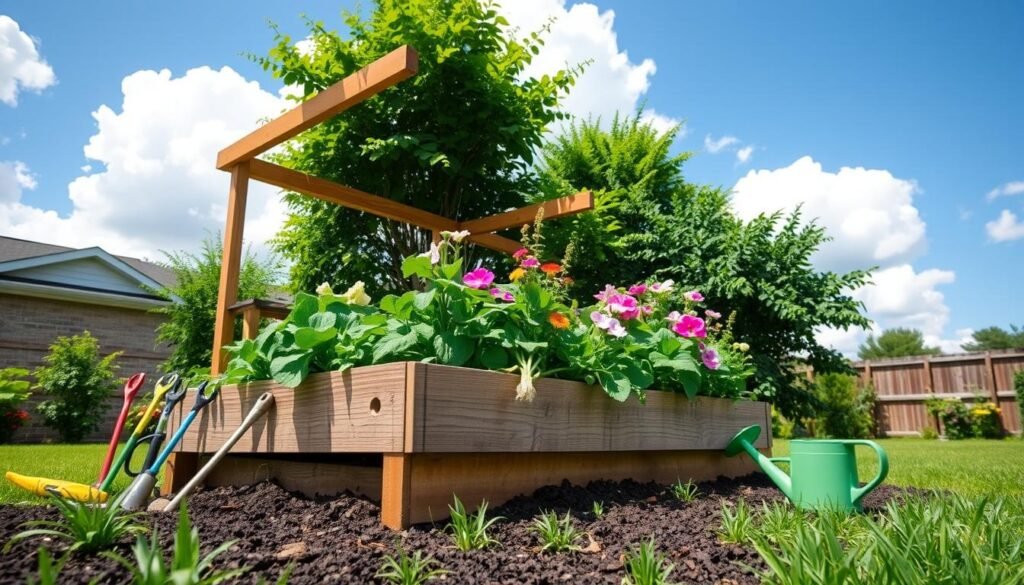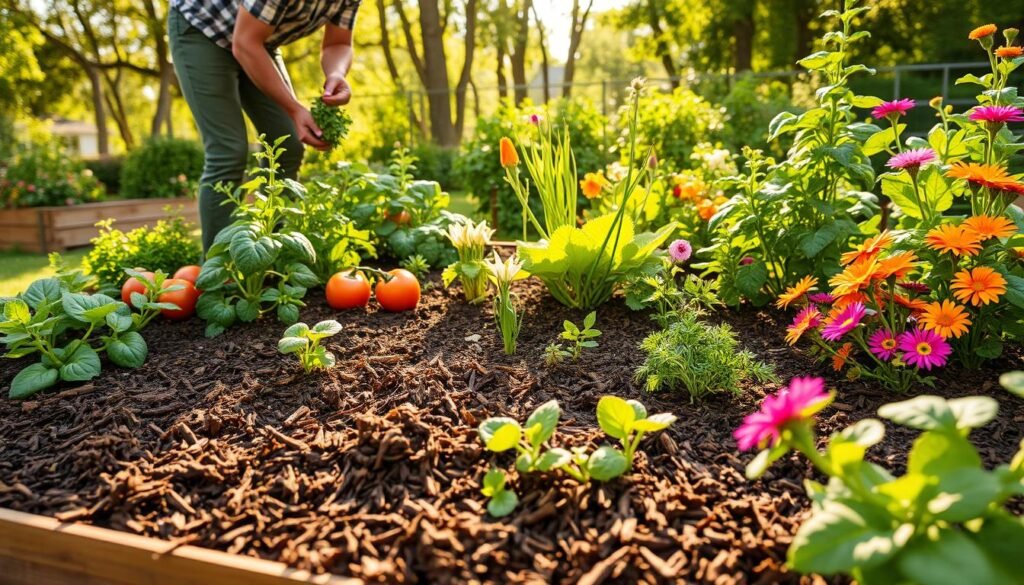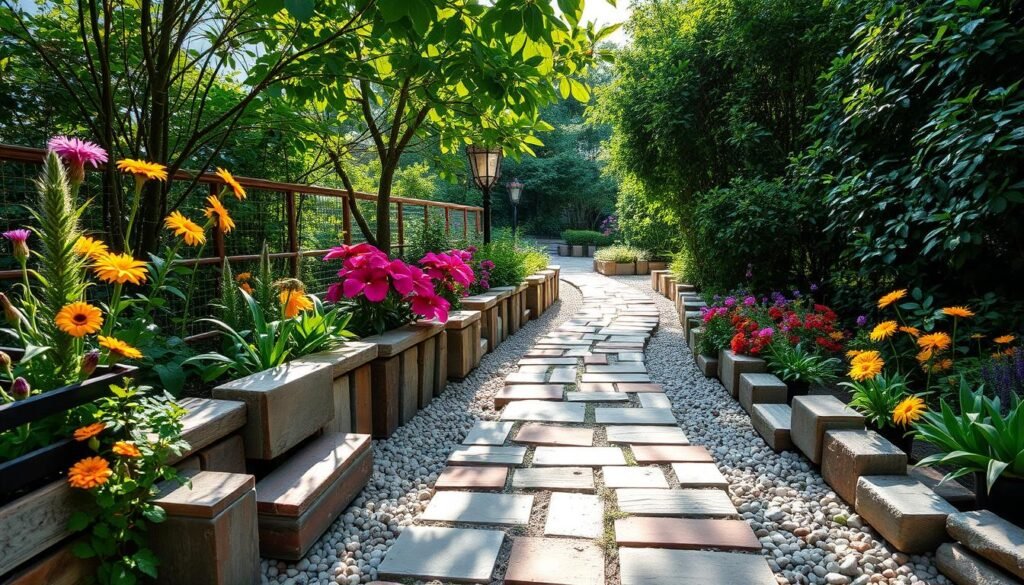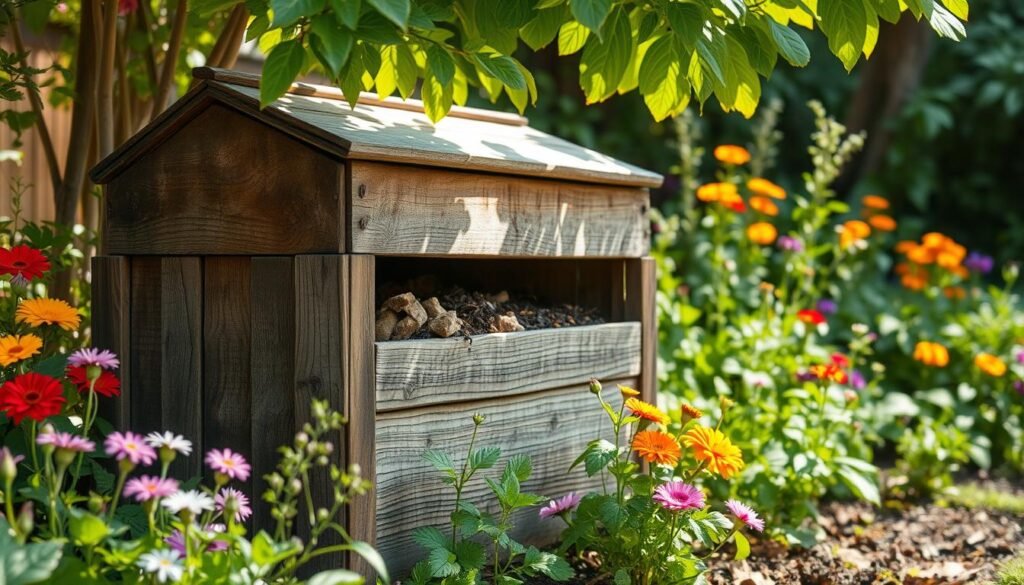Are you tired of dealing with bad soil and poor drainage in your garden? Imagine having a lush, vibrant garden in your backyard. Raised bed gardening is the key to making this dream come true. But how do you start building your own raised garden beds? Get ready to learn the step-by-step guide that will make your gardening dreams a reality.
Key Takeaways
- Understand the benefits of raised bed gardening, including improved drainage and soil quality
- Learn how to plan and choose the right location for your raised garden beds
- Discover the essential materials needed to construct your own raised beds from scratch
- Explore a detailed, easy-to-follow guide for building your personalized raised garden beds
- Discover tips for preparing the soil and choosing the best plants for your raised beds
The Benefits of Raised Bed Gardening
Switching to raised bed gardening brings many perks for both new and seasoned gardeners. These beds not only make your garden look better but also offer real benefits. They can make your gardening more successful and eco-friendly.
Improved Drainage and Soil Quality
One big plus of raised bed gardening is better drainage and soil. Elevating your garden helps your plants grow better. It stops water from pooling, keeping the soil just right for your plants.
You can also pick the soil mix for your raised beds. Add in organic stuff and special helpers to make the soil perfect for your plants. This is great for gardeners with tough soil or small spaces.
Easier Access and Maintenance
Raised beds make gardening easier and more fun. They’re easier on your back and knees, making tasks like planting and weeding less hard. This is good for anyone who has trouble moving or likes gardening without strain.
Also, raised beds keep weeds and pests away. The height stops some pests from getting in. This means you spend less time fighting weeds and pests, letting you enjoy growing your garden more.
Choosing raised bed gardening opens up a world of benefits. It makes gardening more sustainable, efficient, and fun. It’s great for both new and experienced gardeners.
Planning Your Raised Garden Bed
Before starting your diy garden projects, plan the location and size of your raised garden bed carefully. This will make sure your garden looks good and works well for easy gardening for beginners and sustainable gardening techniques.
Choosing the Right Location
When picking the perfect spot for your raised bed, think about sunlight and how easy it is to get to. Choose a spot that gets lots of sunlight, as most plants love it. Also, pick a spot that’s easy to get to so you can take care of your plants without trouble.
Determining the Size and Shape
The size and shape of your raised garden bed should fit your space and needs. You can go for the usual shapes like rectangles and squares, or try something different like curves or L-shapes. Think about how big it should be so you can easily reach all parts of the bed for easy gardening for beginners.
| Raised Bed Size | Suitable for |
|---|---|
| 4’x4′ | Small spaces, beginner gardeners |
| 4’x8′ | Average-sized yards, diverse plants |
| 6’x12′ | Larger gardens, abundant harvests |
Remember, the size and shape of your raised garden bed should match your space, goals, and what you like. By planning well, you’ll start a garden that thrives and is sustainable.
Materials Needed for Building a Raised Garden Bed
To start your diy garden projects, you’ll need different materials. You can choose between wood or composite materials for raised beds. Options include untreated cedar or redwood, or recycled plastic and concrete blocks. You’ll also need good soil, compost, and maybe other additives for your plants.
Here’s what you’ll need to build your raised garden bed:
- Untreated wood (cedar, redwood, or pressure-treated lumber)
- Composite materials (recycled plastic, concrete blocks)
- Screws or nails
- Saw (hand saw or power saw)
- Drill
- Measuring tape
- Level
- Gardening soil
- Compost
- Optional: Landscape fabric or weed barrier
Think about durability, looks, and the environment when picking materials. Wood or composite materials for raised beds both last long. But, each has its own good and bad points.
| Material | Pros | Cons |
|---|---|---|
| Untreated Wood |
|
|
| Composite Materials |
|
|
Think about your budget, design, and upkeep needs when picking materials for your diy garden projects. With the right stuff, you’ll make a beautiful and useful raised garden bed.
A step-by-step guide to constructing your own raised garden beds, perfect for gr
If you’re into DIY garden projects and want to start gardening, building raised garden beds is a great idea. They improve soil quality and make gardening easier, appealing to both new and seasoned gardeners.
In this guide, we’ll show you how to build your own raised garden beds. They’re perfect for growing many types of vegetables. Let’s begin!
- Choose the right location: Pick a spot that gets lots of sunlight and drains well. Stay away from areas with a lot of foot traffic or water.
- Determine the size and shape: Decide on the bed’s size and shape based on your space and needs. Rectangular or square shapes are common, but you can try different designs.
- Gather the necessary materials: You’ll need untreated wood, like cedar or redwood, for the frame. Also, get a good soil mix that’s rich in nutrients.
- Construct the frame: Measure and cut the wood, then build the frame with strong screws or nails. Ensure the corners are square and the bed is level.
- Add the soil: Fill the bed with your chosen soil mix. Spread it evenly and pack it down gently to avoid settling.
- Consider additional features: You can add features like trellises, irrigation systems, or covers to make your garden better.
By following these steps, you’ll create a thriving raised garden bed. It will give you a rich harvest of fresh vegetables for years. Happy gardening!
Preparing the Soil for Your Raised Bed
Getting the soil right is key for a successful raised garden bed. For sustainable gardening, the soil should be rich in nutrients, drain well, and meet the needs of your plants.
Selecting the Right Soil Mix
Choosing the right soil mix is crucial for your plants’ health. A mix of compost, topsoil, and organic materials is ideal. It offers the nutrients and drainage your raised beds need. Here are some tips for the perfect mix:
- Use lots of compost to make the soil richer and better at holding water.
- Mix in topsoil and potting mix for good drainage and air.
- Add perlite or vermiculite for better drainage and air.
- Adjust the soil’s pH to match your plants’ needs, using lime or sulfur.
By preparing the soil well, you set your raised bed up for success. Healthy soil is the base of a thriving garden.
Raised Bed Gardening for Beginners
Starting with raised bed gardening is exciting! It brings many benefits, like better soil and less work. But, picking the right plants is key before you begin.
Choosing the Right Plants
When picking plants for your raised bed, think about a few things:
- Sunlight requirements – Some plants love full sun, while others prefer shade. Make sure your raised beds get the right sunlight for your plants.
- Growth habits – Look at how big each plant will get. Taller plants can shade shorter ones, and vines might need support.
- Design and layout – Consider how plants will look together. Mixing colors, textures, and heights makes your garden beautiful.
Choosing the right plants for your easy gardening for beginners raised bed makes a great garden. It will be productive, beautiful, and bring you joy for years.

“The key to successful raised bed gardening is to choose plants that complement each other and work together to create a balanced, healthy ecosystem.”
Watering and Irrigation Techniques
Keeping your raised garden beds moist is key for their health and growth. Whether you’re new to gardening or have experience, knowing how to water and irrigate is crucial. It can greatly impact your raised bed gardening success.
Hand-watering is a basic yet effective technique. It lets you control how much water each plant gets. This way, the soil stays moist but not too wet. To save water, use a watering can or hose with a soft spray.
Drip irrigation systems are a big step up. They send water straight to the roots, cutting down on evaporation. This method is great for raised beds because it keeps the soil moist and prevents it from getting too wet.
For even more convenience, try an automated irrigation system. These systems can be set to water at certain times. This means your raised beds get the right amount of water, even when you’re not around.
Whatever method you pick, the goal is to keep the soil consistently moist. By mastering watering and irrigation, you can make the most of your raised bed gardening. You’ll enjoy a rich harvest of fresh, healthy food.
Maintenance and Care for Your Raised Garden Bed
Keeping your easy gardening for beginners raised garden bed healthy needs some regular care. But, with the right sustainable gardening techniques, it’s easier. We’ll cover the key tasks like weeding, mulching, and managing pests. These steps will help your raised beds stay in great shape all season.
Weeding and Mulching
Weeding is key for any gardener, especially for raised beds. It stops weeds from taking over your plants’ space and resources. To make weeding easier, add organic mulch around your plants. It keeps weeds down and holds moisture in the soil, cutting down on watering.
- Use a hand hoe or weeding tool to remove weeds at their roots, ensuring they don’t grow back.
- Apply a 2-3 inch layer of organic mulch, such as wood chips, shredded leaves, or straw, around your plants.
- Replenish the mulch as needed throughout the growing season to maintain an effective weed barrier.
By focusing on weeding and mulching, you’ll have a lush, easy-to-care-for easy gardening for beginners raised garden bed. It will show off your sustainable gardening techniques.

| Weed Control Technique | Benefits |
|---|---|
| Hand Weeding | Precise removal of weeds, good for small gardens |
| Mulching | Suppresses weed growth, retains soil moisture |
| Cover Cropping | Improves soil health and competes with weeds |
| Organic Herbicides | Effective weed control without harsh chemicals |
Using these sustainable gardening techniques in your care routine will keep your easy gardening for beginners raised garden bed healthy and weed-free all season.
Troubleshooting Common Raised Bed Issues
Raised bed gardening is a great way to grow a healthy garden. But, even experienced gardeners face challenges. Issues like poor plant growth and pests can happen. But, with the right steps, you can fix these problems and keep your garden thriving.
Soil Compaction and Poor Drainage
One big plus of raised bed gardening is better soil and drainage. But, the soil can get compacted over time. This can make plants grow poorly and waterlogged. To fix this, just loosen the soil with a fork or cultivator. Adding compost can also help with drainage and aeration.
Pest Invasions
Pests like aphids, slugs, and rabbits can harm your garden. To keep them away, try these tips:
- Install physical barriers, such as wire mesh or netting, to keep larger pests at bay.
- Encourage the presence of beneficial insects like ladybugs and lacewings, which prey on common garden pests.
- Use organic pest control methods, such as diatomaceous earth or neem oil, to target specific infestations.
Nutrient Deficiencies
Soil in raised beds can lose nutrients over time. To keep plants healthy, add organic fertilizers or compost regularly. This will help replace lost nutrients.
By tackling these common problems, you can make sure your raised bed gardening is rewarding. With the right solutions, your garden will keep growing well. This will give you a great harvest every season.
Extending the Growing Season with Raised Beds
Raised bed gardening lets you grow plants longer. You can start planting early in spring and keep growing into fall. Learn how to use cold frames, row covers, and more to make your raised beds productive all year.
Raised beds warm up quicker in spring. This means you can plant seeds and move seedlings out sooner than in regular gardens. Adding a cold frame or row cover helps protect plants from frost and cold, giving them a jumpstart.
In fall, raised beds help you keep growing. Hoop houses or mini-greenhouses over your beds protect plants from harsh weather. This way, you can keep growing crops long after frost hits, enjoying a full harvest from spring to autumn.
FAQ
What are the key benefits of raised bed gardening?
Raised bed gardening offers better drainage and soil quality. It also makes gardening easier and more efficient. You can create the perfect growing conditions for your plants.
How do I choose the right location for my raised garden bed?
Look for a spot with plenty of sunlight (at least 6 hours a day). It should also be easy to reach for planting and harvesting. Accessibility is key.
What materials are best for building a raised garden bed?
You can use untreated wood like cedar or redwood. Or, try composite materials like recycled plastic or concrete blocks. Your choice depends on budget and style.
How do I prepare the soil for my raised bed?
Start with a nutrient-rich, well-draining soil mix. Tailor it to your plants’ needs. You might need to add compost or minerals.
What are some good plant choices for a beginner’s raised bed garden?
Beginners should grow leafy greens, tomatoes, peppers, bush beans, and herbs. These are easy to grow and do well in raised beds.
How do I water and irrigate my raised garden bed?
Use hand-watering, drip irrigation, or automated systems. Keep the soil moist but not too wet. This prevents root rot.
What kind of maintenance do raised garden beds require?
Regular tasks include weeding, mulching, and pest checks. Weeding stops competition for resources. Mulching keeps the soil moist and weeds away.
How can I extend the growing season in my raised bed garden?
Use cold frames, row covers, and season-extending structures. They help start plants early and keep them going longer into fall.

